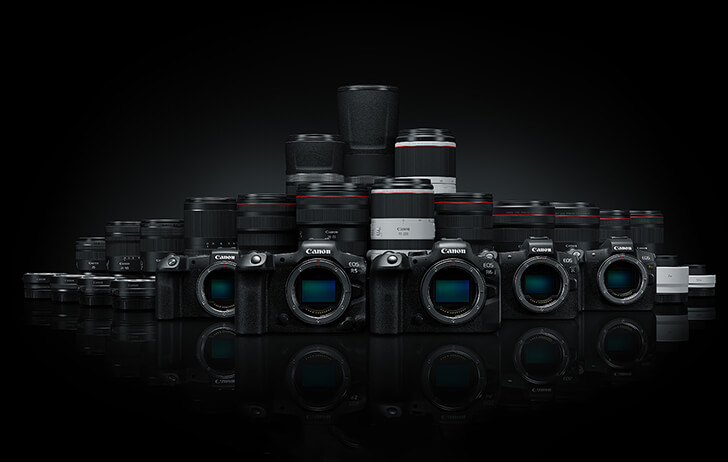The Canon EOS R system launched on September 5, 2018, and began hitting the streets in October of the same year. Commemorating the 3-year anniversary of the new system, Lensrentals.com has done a nice article on the progression of the system.
What Canon has accomplished in 3 years is pretty remarkable when everything the system has to offer is broken down. I would think the system would be even further along if not for all of the challenges that the pandemic has had on labour, manufacturing and logistics.
If we just look at EOS R camera bodies, Canon launched the EOS R in 2018, and in 2019 they brought the EOS RP to market. Both of these camera bodies were built on image sensors that appeared in both the Canon EOS 5D Mark IV and Canon EOS 6D Mark II DSLRs, it wasn't until 2020 that we saw Canon build truly new camera bodies in the Canon EOS R6 and Canon EOS R5. Both cameras have been massively popular.
In 2021, Canon is bringing us the Canon EOS R3, which isn't even going to be at the top of the EOS R lineup. I expect that we're going to see the flagship Canon EOS R1 in late 2022 or early 2023. It is definitely set up to be a remarkable tool as Canon will have to make it something amazing to separate it from the already impressive Canon EOS R3.
In three short years, Canon has also launched 24 new RF mount lenses, which is also a remarkable feat. I expect that we're going to see another 10-15 new lenses over the next couple of years as Canon has always enjoyed having the biggest lens lineup on the market.
Check out the full story at Lensrentals.com


Firmware updates I’d like soon:
Could it be that as far as most M purchasers go the system fulfills their needs and doesn't need radical investment or marginal 'improvements'?
Love this forum. It never disappoints.
Less of a crop in 4K on the mid-tier models would go a long way as well.
Garbage. The R was released with an EF adapter and I still use an EF200 f/2 IS L USM with mine. THere are literally dozens of Canon lenses available to use on the R system and has been since day 1.
The R system also improved the AF of my third party EF glass.
With wikipedia, we can translate 13.846% into any units desired, Chinese or Russian traditional...we might even be able to take a stab at Indus Valley Civilization units.
Or I can just give you the answer off the top of my head, and I am sure PBD knows why and how... :LOL:
They didn't screw up the lens rollout; they screwed up the underfeatured body. One reason why the R sold at all in the beginning was because of the RF 50L, the RF 28-70L and the RF 35. It sold better the next year, once the f/2.8 trinity appeared along with 85 f/1.2s. Not many people jumped into the EOS R because of the R; I sure didn't.
I wasn't planning on jumping on the R bandwagon when it came out, but I saw deals on it that fall, so I did. I tried the R, when a Canon team visited a local camera store. It wasn't categorically better than the 5D4, but it had its advantages. For the next 1-2 years, I used a 5D4 and the R together. After firmware updates, the R was a better tool for portraits, but the 5D4 was still better for sports because the R's EVF was so laggy. I started swapping EF lenses for RF lenses, but I had a large swap after I replaced the 5D4 with the R5. The R5 was THE camera that convinced me to ditch DSLRs, and I haven't looked back since.
By your logic, Canon should have mirrored Nikon with its emphasis on 1.8 primes, but how has that served them? 600-800+ plus for a single f/1.8 lens? And I remember the Z6 and Z7 receiving better reviews than the R (and rightfully so), but where is Nikon now with the Z system? Leading Canon.... nope! Leading with sports lenses made no sense because the R did not do sports well -- the 5D4 was still a superior camera for that genre. NIkon had the perfect opportunity to pass Canon with the introduction of the R/Z ecosystem, and they blew it.
So, thank you Canon, for having launching with the mediocre R. Initial demand was low enough that was I able to get the initial RF lenses at a discount along with the control ring adapter -- objects that became scarce once people saw the value of the R system. I bought the 24-105 with the body as a kit, but I got good deals on the other 3 lenses. And thanks to CanonRumors/CanonPriceWatch I was able to source the subsequent RF lenses without much issue.
The lens rollout was done the correct way. Higher-margin, lower yield lenses. You don't start with a bunch of lenses that you need to sell a ton of to make it worthwhile when there is basically one camera body coming to the market that can use them. The true amateur market was not and still isn't the target market for the EOS R lineup. We'll see that come to pass once manufacturing woes improve and they announce replacements for the EOS RP and EOS R.
So, a comment like ‘Canon blew it by not having every popular lens available in a native mount at EOS R launch’ is asinine, because most EOS R buyers already owned their chosen set of EF lenses that were readily adapted.
And also some really nice lens upgrades of old popular lenses.... like a compact and sharp 135 f1.8 IS (maybe with 1:2 macro?!)
There are so many options...and not used opportunities... like a 120-300 2.8 etc.. or 300-800 5.6 ;P